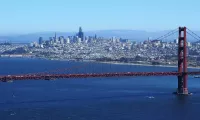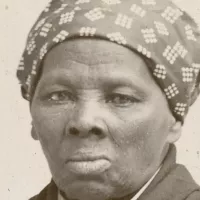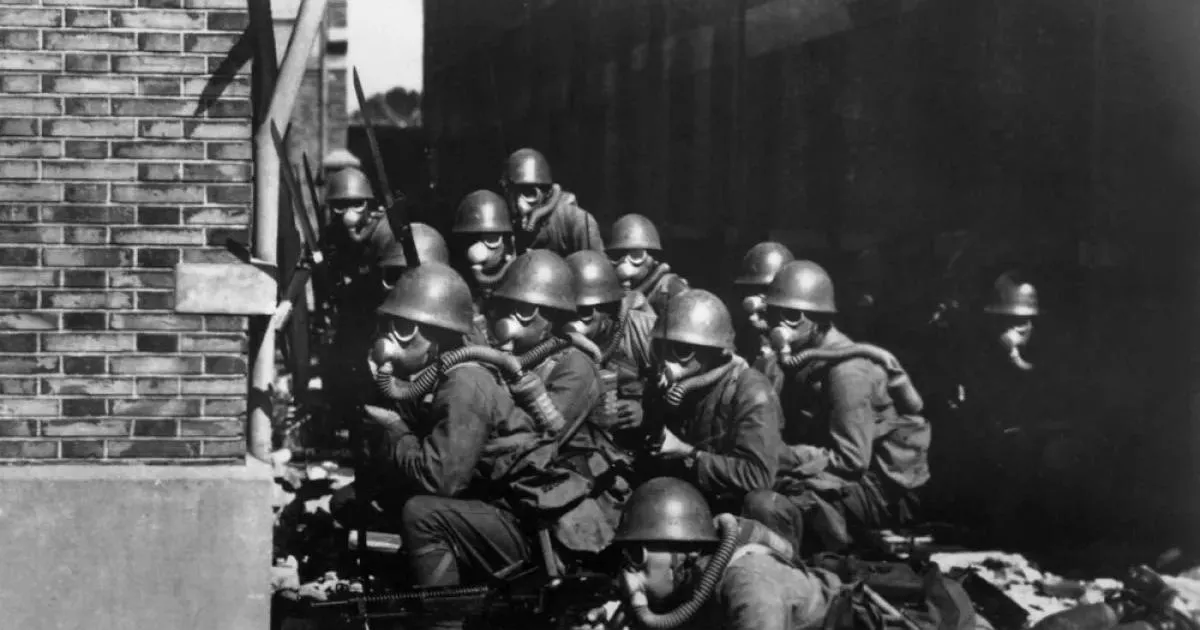The Second Sino-Japanese War, fought between China and Japan from 1937 to 1945, is considered a major part of World War II and marked the beginning of WWII in Asia. Preceded by Japanese aggression in Manchuria starting in 1931, the conflict involved large-scale war crimes against Chinese civilians. Known in China as the War of Resistance against Japanese Aggression, it was the largest Asian war of the 20th century, characterized by immense suffering and widespread devastation.
1905: Japan Defeats Russia in Russo-Japanese War
In 1905, Japan defeated the Russian Empire in the Russo-Japanese War, gaining Dalian and southern Sakhalin and establishing a protectorate over Korea. This further strengthened Japan's position as a great power and contributed to its later expansionist policies.
1907: Hague Conventions of 1907
Despite Article 23 of the Hague Conventions of 1899 and 1907, the Imperial Japanese Army frequently used chemical weapons during the war.
1911: Uprising Against Qing Government
In 1911, factions of the Qing Army uprose against the government, initiating a revolution that spread across China's southern provinces.
March 1912: Proclamation of the Beiyang Government
In March 1912, the new Beiyang government of China was proclaimed, after Yuan Shikai agreed to abolish the monarchy and establish a new republican government under the condition he be appointed president of China.
1913: Assassination of Song Jiaoren
In 1913, the parliamentary political leader Song Jiaoren was assassinated. It is generally believed Yuan Shikai ordered the assassination. Yuan Shikai then forced the parliament to pass a bill to strengthen the power of the president and sought to restore the imperial system, becoming the new emperor of China.
June 1916: Death of Yuan Shikai
In June 1916, Yuan Shikai died, leading to control of China falling into the hands of the Beiyang Army leadership. The Beiyang government was a military dictatorship, and China was reduced to a fractured state, leading to economic decline and instability. This presented an opportunity for nationalistic politicians in Japan to press for territorial expansion.
November 1918: Armistice of 11 November 1918
In November 1918, the Armistice of 11 November 1918 took place on the eleventh hour of the eleventh day of the eleventh month. The Japanese forces in China formally surrendered on 9 September 1945, at 9:00. The ninth hour of the ninth day of the ninth month was chosen in echo of the Armistice of 11 November 1918.
1921: Imperial Eastern Region Conference
In 1921, the Imperial Eastern Region Conference reconfirmed Japan's commitment to be the dominant power in the Northeast.
1926: Kuomintang Launches Northern Expedition
From 1926 to 1928, the Kuomintang (KMT) in Guangzhou launched the Northern Expedition with limited assistance from the Soviet Union for the purpose of unifying China and defeating the regional warlords.
1927: Shanghai Massacre
In 1927, the Chinese Communist Party (CCP) fought openly against the Nanjing government after the Shanghai massacre.
1927: Start of Chinese Civil War
In 1927, the Chinese Nationalist forces led by Chiang Kai-shek and the Communist forces led by Mao Zedong started fighting each other in the Chinese Civil War.
1927: Imperial Eastern Region Conference
In 1927, the Imperial Eastern Region Conference reconfirmed Japan's commitment to be the dominant power in the Northeast.
1928: Kuomintang Launches Northern Expedition
From 1926 to 1928, the Kuomintang (KMT) in Guangzhou launched the Northern Expedition with limited assistance from the Soviet Union for the purpose of unifying China and defeating the regional warlords.
1928: Zhang Xueliang Declares Allegiance to Nationalist Government
In 1928, after Zhang Zuolin's assassination, his son Zhang Xueliang took over as the leader of the Fengtian clique in Manchuria and declared his allegiance to the Nationalist government in Nanjing under Chiang Kai-shek. As a result, China was nominally reunified under one government.
1928: Jinan Incident
In 1928, conflicts between the National Revolutionary Army and the Japanese garrison in Shandong escalated into the Jinan incident, during which the Japanese military killed several Chinese officials and fired artillery shells into Jinan. Around 6,123 Chinese civilians were killed. Relations between the Chinese Nationalist government and Japan severely worsened.
November 1929: Conflict over the Chinese Eastern Railroad
The conflict over the Chinese Eastern Railroad (CER) during July-November 1929 increased tensions in the Northeast that led to the Mukden Incident and eventually the Second Sino-Japanese War. The Soviet Red Army victory over Xueliang's forces revealed Chinese military weaknesses.
1929: Soviet Red Army Victory
In 1929, the Red Army victory shook that policy to the core and reopened the Manchurian problem.
1930: Kwantung Army Realizes Red Army Strength
By 1930, the Kwantung Army realized they faced a Red Army that was only growing stronger. The time to act was drawing near and Japanese plans to conquer the Northeast were accelerated.
1930: Central Plains War Breaks Out
In 1930, the Central Plains War broke out across China, involving regional commanders. The Kuomintang government in Nanjing decided to focus their efforts on suppressing the Chinese Communists through the Encirclement Campaigns, following the policy of "first internal pacification, then external resistance".
September 1931: Mukden Incident
In September 1931, Japan invaded Manchuria after the Mukden Incident. Japanese soldiers set off a bomb on the Southern Manchurian Railroad to provoke an opportunity to act in "self-defense."
September 1931: Japanese Invasion of Manchuria
Some Chinese historians believe the 18 September 1931 Japanese invasion of Manchuria marks the start of the War of Resistance.
1931: Criticism of Zhang Xueliang
After the Mukden Incident in 1931, Chinese public opinion strongly criticized Manchuria's leader, Zhang Xueliang, for his non-resistance to the Japanese invasion.
1931: Japanese invasion of Manchuria
In 1931 the Japanese invasion of Manchuria occurred which some historians consider to be the start of the Second Sino-Japanese War.
April 1932: Chinese Soviet Republic Declares War on Japan
On 15 April 1932, the Chinese Soviet Republic led by the Communists declared war on Japan.
1933: Tanggu Truce
After the Tanggu Truce of 1933, Chiang Kai-Shek and the British government would have more friendly relations but were uneasy due to British foreign concessions there.
1933: Japanese Attack the Great Wall Region
In 1933, the Japanese attacked the Great Wall region, and the Tanggu Truce established in its aftermath gave Japan control of Rehe Province and a demilitarized zone between the Great Wall and the Beijing-Tianjin region.
1933: Wheat and Cotton Loan
In 1933, the Wheat and Cotton Loan mainly benefited American producers, while aiding to a smaller extent both Chinese and Japanese alike.
1933: Chiang Kai-shek's Encirclement of Chinese Communists
In late 1933, Chiang Kai-shek attempted to destroy the Chinese Communists by encircling them, forcing them into the Long March and resulting in the Communists losing around 90% of their men.
1934: US State Department memo on Standard Oil
In 1934, a U.S. State Department memo noted that Japan's business dealings with Standard Oil of New Jersey company made United States oil the "major portion of the petroleum and petroleum products now imported into Japan."
1934: Silver Purchase Act
In 1934, the Silver Purchase Act signed by President Roosevelt caused chaos in China's economy which helped the Japanese war effort.
1934: Anti-Japanese feeling in Gansu
John Scott reported in 1934 that there was both strong anti-Japanese feeling and anti-Bolshevik among the Muslims of Gansu and he mentioned the Muslim generals Ma Fuxiang, Ma Qi, Ma Anliang and Ma Bufang who was chairman of Qinghai province when he stayed in Xining.
1935: He-Umezu Agreement and Chin-Doihara Agreement Signed
In 1935, China signed the He–Umezu Agreement, forbidding the KMT from conducting party operations in Hebei under Japanese pressure. In the same year, the Chin–Doihara Agreement was signed, expelling the KMT from Chahar.
May 1936: Mongol Military Government Formed
On 12 May 1936, the Mongol military government was formed in the empty space of Chahar with Japan providing all the necessary military and economic aid.
December 1936: Xi'an Incident
In December 1936, the Xi'an Incident, a coup by two Nationalist Generals, forced Chiang Kai-shek to accept a United Front with the Communists to oppose Japan.
1936: Chinese-American pilots sent to Germany
In 1936, several Chinese-American volunteer pilots were sent to Lagerlechfeld Air Base in Germany for aerial-gunnery training by the Chinese Air Force.
1936: Second United Front Formed
In late 1936, Chiang Kai-shek was forced to form the Second United Front with the Communists to resist the imminent Japanese invasion.
July 1937: Marco Polo Bridge Incident
On the night of 7 July 1937, Chinese and Japanese troops exchanged fire in the vicinity of the Marco Polo (or Lugou) Bridge, about 16 km from Beijing. The initial skirmishing soon escalated into a full-scale battle.
July 1937: Start of Second Sino-Japanese War
The Second Sino-Japanese War lasted eight years, two months and two days (from 7 July 1937, to 9 September 1945).
August 1937: Japanese Capture of Beijing and Tianjin
By August 1937, Japan had occupied Beijing and Tianjin, concluding the Beijing-Tianjin campaign. The Japanese captured Beijing and the Taku Forts at Tianjin on 29 and 30 July respectively, after the Chinese 29th Army was forced to withdraw after 24 days of combat.
August 1937: Escalation of Conflict in Shanghai
Following the shooting of two Japanese officers attempting to enter the Hongqiao military airport on 9 August 1937, Japan demanded the withdrawal of all Chinese forces from Shanghai, which was refused. Both sides marched reinforcements into Shanghai, leading to the escalation of the conflict.
August 1937: Heavy Losses for Imperial Japanese Navy in Shanghai
In the three days from 14 to 16 August 1937, the Imperial Japanese Navy (IJN) sent many sorties of the then-advanced long-ranged G3M medium-heavy land-based bombers and assorted carrier-based aircraft expecting to destroy the Chinese Air Force. However, the Imperial Japanese Navy encountered unexpected resistance from the defending Chinese Curtiss Hawk II/Hawk III and P-26/281 Peashooter fighter squadrons; suffering heavy (50%) losses from the defending Chinese pilots. August 14 was subsequently commemorated by the KMT as China's Air Force Day.
August 1937: Battle of Shanghai Begins
On 13 August 1937, Kuomintang soldiers attacked Japanese Marine positions in Shanghai, leading to the Battle of Shanghai. On 14 August, Chinese forces were ordered to capture or destroy the Japanese strongholds in Shanghai, resulting in bitter street fighting. Kuomintang planes accidentally bombed the Shanghai International Settlement, causing more than 3,000 civilian deaths.
September 1937: Sino-Soviet Non-Aggression Pact signed
In September 1937, the Soviet Union signed the Sino-Soviet Non-Aggression Pact with China and approved Operation Zet, forming a secret Soviet volunteer air force to support China against Japan.
September 1937: Japanese Achieve Air Superiority
The skies of China had become a testing zone for advanced biplane and new-generation monoplane combat-aircraft designs. The introduction of the advanced A5M "Claude" fighters into the Shanghai-Nanjing theater of operations, beginning on 18 September 1937, helped the Japanese achieve a certain level of air superiority.
November 1937: Japanese Campaign Against Nanjing and Northern Shanxi
In November 1937, the Japanese concentrated 220,000 soldiers and began a campaign against Nanjing. The IJA also advanced on and captured Northern Shanxi in September – November 1937.
December 1937: Japanese Capture Nanjing
Building on the hard-won victory in Shanghai, the Imperial Japanese Army advanced on and captured the KMT capital city of Nanjing in December 1937.
December 1937: Japanese attack on USS Panay and Nanjing Massacre
In December 1937, events such as the Japanese attack on USS Panay and the Nanjing Massacre swung public opinion in the West sharply against Japan and increased their fear of Japanese expansion.
December 1937: Nanjing Massacre
Upon the capture of Nanjing, after 13 December 1937, Japanese forces committed massive war atrocities, including mass murder and rape of Chinese civilians. Over the next several weeks, Japanese troops perpetrated numerous mass executions and tens of thousands of rapes. The army looted and burned the surrounding towns and the city, destroying more than a third of the buildings.
1937: Nationalist Army did little to oppose Japanese encroachment into China
From 1931 until summer 1937, the Nationalist Army under Chiang Kai-shek did little to oppose Japanese encroachment into China.
1937: Japanese Losses in China From 1937
From 1937 to 1941, 185,647 Japanese soldiers were killed in China and 520,000 were wounded. From 1937 to 1941, 430,000 Japanese soldiers were recorded as being sick. Disease also incurred critical losses on Japanese forces.
1937: Soviet Aid
From 1937, the Soviets provided the greatest material help for China, with fighter aircraft for the Nationalist Chinese Air Force and artillery and armour for the Chinese Army through the Sino-Soviet Treaty; Operation Zet also provided for a group of Soviet volunteer combat aviators to join the Chinese Air Force.
1937: Sheng Shicai invades Dunganistan
In 1937, General Sheng Shicai, accompanied by Soviet troops, invaded Dunganistan to defeat General Ma Hushan of the KMT 36th Division. The Nationalist government denied these maneuvers.
1937: Start of the Second Sino-Japanese War
In 1937, the Second Sino-Japanese War between the Republic of China and the Empire of Japan officially began, though localized conflict in Manchuria started in 1931. It is considered a part of World War II and seen as the beginning of World War II in Asia.
1937: Sino-Soviet Non-Aggression Pact
In 1937, with the outbreak of full-scale war, the Soviet Union became the primary supporter for China's war of resistance through the Sino-Soviet Non-Aggression Pact from 1937 to 1941.
1937: Inspiration of Sword March
The 29th Army's resistance (and poor equipment) inspired the 1937 "Sword March", which became the National Revolutionary Army's standard marching cadence and popularized the racial epithet guizi to describe the Japanese invaders.
1937: Start of "Total" War Period
Under the Chinese government's interpretation, the 1937–1945 period is viewed as a period of "total" war.
January 1938: Decline of Conventional Kuomintang Resistance
By January 1938, most conventional Kuomintang forces had either been defeated or no longer offered major resistance to Japanese advances.
March 1938: Japanese Control Almost All of North China
By March 1938, the Japanese controlled almost all of North China. However, Communist-led rural resistance to the Japanese remained active.
April 1938: Chinese Victory at the Battle of Taierzhuang
The Japanese were decisively defeated at the Battle of Taierzhuang in March–April 1938, with the Chinese using night attacks and close-quarters combat to overcome Japanese advantages in firepower. The Chinese also severed Japanese supply lines from the rear, forcing the Japanese to retreat in the first Chinese victory of the war.
May 1938: League of Nations Condemnation
Despite Article 23 of the Hague Conventions of 1899 and 1907, article V of the Treaty in Relation to the Use of Submarines and Noxious Gases in Warfare, article 171 of the Treaty of Versailles and on 14 May 1938, a resolution was adopted by the League of Nations condemning the use of poison gas by the Empire of Japan.
June 1938: Yellow River Flood
The 1938 Yellow River flood (simplified Chinese: 花园口决堤事件; traditional Chinese: 花園口決堤事件; pinyin: Huāyuánkǒu Juédī Shìjiàn; lit. 'Huayuankou Dam Burst Incident') was a man-made flood created by the intentional destruction of levees on the Yellow River in Huayuankou, Henan by the National Revolutionary Army (NRA) during the Second Sino-Japanese War. The first wave of floods hit Zhongmu County on 13 June 1938.
October 1938: Authorization of Toxic Gas Use
From August to October 1938, the Emperor authorized the use of toxic gas on 375 separate occasions during the Battle of Wuhan.
1938: Australia bans iron ore exports
In 1938, Australia prevented a Japanese government-owned company from taking over an iron mine in Australia, and banned iron ore exports.
1938: Ma Bufang becomes chairman of Qinghai
In 1938, Ma Bufang became chairman (governor) of Qinghai and commanded a group army. He was appointed because of his anti-Japanese inclinations.
1938: Nationalist Government Relocates to Chongqing
In 1938, after failing to stop the Japanese capture of Wuhan, the Nationalist government, then based in Wuhan, relocated to Chongqing.
1938: Cooperation during Battle of Wuhan
In 1938, the Red Army fought alongside KMT forces during the Battle of Wuhan, marking the high point of their cooperation.
1938: American supply of war materials to Japan
Until the summer of 1938, Japan was allowed to purchase aerial bombs, aircraft equipment, and aircraft from America. Japan's military machine acquired war materials, automotive equipment, steel, scrap iron, copper, oil, that it wanted from the United States in 1937–1940.
April 1939: US Congress hearing on Neutrality Act
On Wednesday, 19 April 1939, Maxwell S. Stewart testified before the United States Congress House of Representatives Committee on Foreign Affairs. Stewart stated that America's Neutrality Act was benefiting Japan, who could not have invaded China without the raw materials imported from America.
June 1939: Red Army attacks Chinese militia
In June 1939, The Red Army led by He Long attacked and wiped out a brigade of Chinese militia led by Zhang Yin-wu in Hebei.
July 1939: UK recognizes Japanese conquests in China
In July 1939, negotiations led to an agreement by which the United Kingdom recognized Japanese conquests in China.
September 1939: Soviet Union defeats Japan in Battles of Khalkhin Gol
In May-September 1939, the Soviet Union defeated Japan in the Battles of Khalkhin Gol, deterring further Japanese aggression towards the Soviets.
November 1939: Chinese Nationalist Forces Launch Winter Offensive
In November 1939, Chinese nationalist forces launched a large scale winter offensive against the Japanese.
December 1939: US Trade Embargoes Begin
In December 1939, as Japanese aggression continued, the United States responded with trade embargoes on various goods, including oil and petroleum.
December 1939: Chinese Counter-Offensive Defeated
In December 1939, the Chinese launched their first large-scale counter-offensive against the Imperial Japanese Army (IJA), but it was defeated due to low military-industrial capacity and limited experience in modern warfare.
1939: China Divided
By 1939, the Nationalist army had retreated to the southwest and northwest of China, while the Japanese controlled the coastal cities that were previously Nationalist power centers. China became divided into three regions: Japanese-occupied territories, Nationalist-controlled regions, and Communist-controlled regions.
1939: Mao Zedong calls for active resistance
In 1939, Mao Zedong wrote The Greatest Crisis under Current Conditions, advocating for increased resistance against Japan and the strengthening of the Second United Front.
1939: Defense of Changsha
In 1939, the successful defense of Changsha occurred, during which heavy casualties were inflicted on the Imperial Japanese Army (IJA).
1939: New Phase of the War
In 1939, the war entered a new phase marked by the Japanese defeat at the Battle of Suixian–Zaoyang and the First Battle of Changsha.
July 1940: US Trade Embargoes Continue
In July 1940, the United States expanded trade embargoes on Japan to include scrap iron and munitions.
August 1940: Communist Forces Launch Hundred Regiments Offensive
In August 1940, communist forces launched the Hundred Regiments Offensive in central China.
October 1940: US continues trade with Japan
Until October 16, 1940, the US government extended a trade agreement with Japan, under which Japan purchased trucks for the Kwantung Army, machine tools for aircraft factories, strategic materials (steel and scrap iron), and various other supplies.
1940: Japanese Puppet Governments
After 1940, facing difficulties in administering occupied territories, the Japanese implemented a strategy of creating friendly puppet governments. However, atrocities by the Imperial Japanese Army and refusal to delegate real power made the puppets unpopular and ineffective.
1940: Taisei Yokusankai Launched
In 1940, Japanese prime minister Fumimaro Konoe launched the Taisei Yokusankai.
1940: Gentlemen's agreement on French Indochina
In 1940, a gentlemen's agreement was made not to move into southern French Indochina.
1940: US export destination
In 1940, according to the United States Congress, Japan was the U.S.'s third largest export destination until France overtook it due to France being at war.
1940: Chinese Red Army Offensive and Japanese Retaliation
In 1940, the Chinese Red Army launched a major offensive in north China, destroying railways and a major coal mine. These operations frustrated the Imperial Japanese Army and led them to employ the Three Alls policy (kill all, loot all, burn all), during which most of the Japanese war crimes were committed.
1940: Bombing of Ningbo with Plague-Carrying Fleas
In 1940, the Imperial Japanese Army Air Force bombed Ningbo with fleas carrying the bubonic plague.
1940: Nationalist Critique of Japanese Casualty Estimates
In 1940, the Nationalist Chinese authorities, via the National Herald, criticized Japanese estimates of Chinese casualties, accusing them of exaggeration while concealing their own losses.
1940: Increased Conflict
Starting in 1940, open conflict between Nationalists and Communists became more frequent in the occupied areas outside of Japanese control.
January 1941: New Fourth Army Incident
Open conflict between Nationalists and Communists became more frequent in the occupied areas outside of Japanese control, culminating in the New Fourth Army Incident in January 1941.
February 1941: Sino-British agreement
In February 1941 a Sino-British agreement was forged whereby British troops would assist the Chinese "Surprise Troops" units of guerrillas already operating in China, and China would assist Britain in Burma.
April 1941: Soviet aid to China ends
In April 1941, Soviet aid to China ended with the Soviet–Japanese Neutrality Pact, enabling the Soviet Union to avoid fighting Germany and Japan simultaneously.
May 1941: China becomes beneficiary of Lend-Lease Act
On May 6, 1941, China became a beneficiary of the U.S. Lend-Lease Act, marking a shift in its primary diplomatic and military support to the United States.
June 1941: Germany attacks the Soviet Union
On 22 June 1941, Germany attacked the Soviet Union, resulting in a realignment of political outlooks and strategic prospects.
June 1941: US continues trade with Japan
Until June 26, 1941, the US government extended a trade agreement with Japan, under which Japan purchased petrol and petroleum products.
July 1941: US Freezes Japanese Assets
In July 1941, trade negotiations between the United States and Japan failed, leading the United States to freeze Japanese financial assets and obtain Dutch and British agreements to cut oil exports to Japan.
October 1941: Use of Chemical Weapons in Yichang
During the battle in Yichang in October 1941, Japanese troops utilized chemical munitions in artillery and mortar fire, and warplanes dropped gas bombs, severely impacting Chinese troops due to their lack of protective equipment.
December 1941: Japan Attacks Pearl Harbor
In December 1941, Japan launched a surprise attack on Pearl Harbor and declared war on the United States. Following this, the US increased its aid to China under the Lend-Lease Act.
December 1941: Formal Declaration of War and Name Change
In December 1941, when both sides formally declared war, the name was replaced by "Greater East Asia War".
December 1941: Establishment of the British Army Aid Group
When Hong Kong was overrun in December 1941, the British Army Aid Group (B.A.A.G.) was set up and headquartered in Guilin, Guangxi. Its aim was to assist prisoners of war and internees to escape from Japanese camps.
1941: Territorial Control and Guerilla Warfare
By 1941, Japan had occupied much of north and coastal China, but the KMT central government and military had retreated to the western interior, while the Chinese communists remained in control of base areas in Shaanxi. Japanese control was limited to railroads and major cities, with Chinese guerrillas roaming freely in the countryside.
1941: Communist strategy shift by end of 1941
By the end of 1941, the Communist forces shifted their strategy to primarily engage in a political offensive against the Japanese while declaring that the CCP should "save and preserve our strength and wait for favourable timing".
1941: Japanese Losses in China From 1941
From 1941 to 1945: 202,958 Japanese soldiers were dead; another 54,000 dead after war's end.
1941: Japanese aerial bombardment of Xining
In 1941, Xining was subjected to aerial bombardment by Japanese warplanes, causing all ethnicities in Qinghai to unite against the Japanese. General Han Youwen directed the defense of the city.
1941: Air-dropping of Plague-Contaminated Fleas on Changde
In 1941, some 40 members of Unit 731 air-dropped plague-contaminated fleas on Changde, causing epidemic plague outbreaks.
1941: Defense of Changsha
In 1941, the successful defense of Changsha occurred, during which heavy casualties were inflicted on the Imperial Japanese Army (IJA).
1941: Creation of American Volunteer Groups (AVG)
In mid-1941, the United States government financed the creation of the American Volunteer Groups (AVG), of which one the "Flying Tigers" reached China, to replace the withdrawn Soviet volunteers and aircraft. The Flying Tigers' early combat success earned them wide recognition and their "boom and zoom" tactics would be adopted by the United States Army Air Forces.
1941: Japanese Occupation of Shanghai International Settlement and French Concession
Japan moved into the Shanghai International Settlement and the Shanghai French Concession in 1941 after its declaration of war against the United States and the United Kingdom.
February 1942: First B.A.A.G. operation
The first operation of the British Army Aid Group (B.A.A.G.) commenced in February 1942 from Burma on a long journey to the Chinese front. Due to issues with supporting the Chinese and gradual disease and supply issues, the first phase achieved very little and the unit was withdrawn in September.
April 1942: Closure of Burma Road
After the Japanese blocked the Burma Road in April 1942, US and British supplies to the Chinese were delivered via airlift over the Himalayas known as "The Hump".
April 1942: Battle of Yenangyaung
On April 16, 1942, during the Battle of Yenangyaung in Burma, 7,000 British soldiers were encircled by the Japanese 33rd Division and rescued by the Chinese 38th Division.
May 1942: Zhejiang-Jiangxi Campaign
The Imperial Japanese Army started the Zhejiang-Jiangxi Campaign on May 15, 1942, with the goal of finding surviving American airmen after the Doolittle Raid, applying retribution on the Chinese who aided them and destroying air bases. During this campaign, the Imperial Japanese Army left behind a trail of devastation and also spread cholera, typhoid, plague and dysentery pathogens.
July 1942: Chiang directs Ma Buqing to move troops
In July 1942, Chiang Kai-shek directed General Ma Buqing to move 30,000 of his troops to the Tsaidam marsh in the Qaidam Basin of Qinghai. Chiang also named Ma as Reclamation Commissioner.
1942: Recruitment of Chinese covert operatives
In 1942, American and Canadian-born Chinese were recruited as covert operatives in Japanese-occupied China. Their mission was to blend in, destroy Japanese transportation of supplies, and signal bomber destruction of railroads and bridges.
1942: Chiang named Allied commander-in-chief
In 1942, Chiang Kai-shek was named Allied commander-in-chief in the China theater. American general Joseph Stilwell served as Chiang's chief of staff. Relations between Stilwell and Chiang broke down due to differing strategies; Stilwell favored an aggressive approach, while Chiang preferred a defensive posture, which led to the Allies losing confidence in Chinese offensive capabilities.
1942: American Volunteer Group
In 1942, Claire Lee Chennault commanded the 1st American Volunteer Group (nicknamed the Flying Tigers).
1942: Japan's Focus on Communist Bases
In 1942, Japan concentrated most of its forces in China in an effort to defeat the Communist bases behind Japan's lines. To decrease guerilla's human and material resources, the Japanese military implemented its Three Alls policy. In response, the Communist armies increased their role in production activities, including farming, raising hogs, and cloth-making.
1942: Allied Disagreements on Strategy
In 1942, disagreements persisted among China, the United States, and the United Kingdom regarding strategy. Winston Churchill hesitated to commit British troops to reopen the Burma Road, while Stilwell considered it crucial. Chiang supported the Indian independence movement, straining relations with the United Kingdom, and wanted to divert troops to protect American airbases from which he hoped to defeat Japan through bombing, an idea Stilwell opposed.
1942: Creation of Sino-American Cooperative Organization
In 1942, the Sino-American Cooperative Organization was created by the SACO Treaty signed by the Republic of China and the United States of America, establishing a mutual intelligence gathering entity in China. It operated in China jointly along with the Office of Strategic Services (OSS) and served as joint training program between the two nations.
1942: Sheng Shicai turns anti-Soviet
In 1942, the Soviet Union refused to allow the United States to supply China through Kazakhstan into Xinjiang as the Xinjiang warlord Sheng Shicai had turned anti-Soviet with Chiang's approval.
February 1943: Second phase of B.A.A.G. operations
Commencing in February 1943, the second phase of the British Army Aid Group (B.A.A.G.) operations provided valid assistance to the Chinese 'Surprise Troops' in various actions against the Japanese involving ambushes, attacks on airfields, blockhouses, and supply depots.
February 1943: Chinese forces advance to northern Burma.
In February 1943, the second phase of the British and Commonwealth forces operation in Mission 204 commenced, which attempted to provide assistance to the Chinese Nationalist Army.
1943: Famine in Guangdong
By 1943, Guangdong experienced famine, with reports indicating that 600,000 people were killed in Siyi by starvation.
1943: Chinese repel Japanese Offensives
Despite the severe shortage of matériel, in 1943, the Chinese were successful in repelling major Japanese offensives in Hubei and Changde.
November 1944: Ili Rebellion breaks out
In November 1944, the Ili Rebellion broke out in Xinjiang when the Kuomintang Hui Officer Liu Bin-Di was killed while fighting Turkic Uyghur rebels. The Soviet Union supported the Turkic rebels against the Kuomintang.
November 1944: Withdrawal of B.A.A.G. operations
In November 1944, the second phase of the British Army Aid Group (B.A.A.G.) operations was withdrawn.
November 1944: Japanese Advance Slows Near Chongqing
In late November 1944, the Japanese advance slowed approximately 300 miles from Chongqing due to shortages. Operation Ichi-Go achieved its goals but too late to impact the war, and American bombers were moved to the Mariana Islands.
1944: Chinese forces join forces in Mong-Yu
By the end of 1944, Chinese troops joined forces in Mong-Yu, successfully driving the Japanese out of North Burma and securing the Ledo Road.
1944: Japan Launches Operation Ichi-Go
In 1944, Japan launched Operation Ichi-Go, the invasion of Henan and Changsha.
1944: Communist Counteroffensives Launched
In 1944, the Communist forces launched counteroffensives from the liberated areas against Japanese forces.
1944: Japanese Operation Ichi-Go offensive
In 1944, the Japanese Operation Ichi-Go offensive compelled the evacuation.
May 1945: Japanese Soldiers Captured by May 1945
By May 1945, Chinese forces report that 22,293 Japanese soldiers were captured as prisoners.
August 1945: Soviet Union invades Manchuria
In August 1945, the Soviet Union annulled the neutrality pact with Japan and invaded Manchuria, Inner Mongolia, the Kuril Islands, and northern Korea, while also continuing to support the Chinese Communist Party.
August 1945: Emperor Hirohito capitulates
On 15 August 1945, Japanese Emperor Hirohito officially capitulated to the Allies after the Kwantung Army was destroyed by the Soviets.
August 1945: US and British supplies to the Chinese delivered via airlift over the Himalayas ends
The airlift of US and British supplies to the Chinese over the Himalayas known as "The Hump" continued daily to August 1945, at great cost in men and aircraft.
September 1945: Japanese forces surrender in China
In September 1945, General Douglas MacArthur ordered all Japanese forces within China (excluding Manchuria), Taiwan and French Indochina north of 16° north latitude to surrender to Chiang Kai-shek. The formal surrender occurred on September 9, 1945, at 9:00, a time chosen to echo the Armistice of 11 November 1918 and symbolize lasting peace.
September 1945: Japan Formally Surrenders
On 2 September 1945, Japan formally surrendered, following the atomic bombings of Hiroshima and Nagasaki, Soviet declaration of war, and subsequent invasions of Manchukuo and Korea. China regained all territories lost and became one of the five permanent members of the United Nations Security Council.
September 1945: Official surrender ceremony aboard USS Missouri
On 2 September 1945, the official surrender was signed aboard the battleship USS Missouri in a ceremony where several Allied commanders including Chinese general Hsu Yung-chang were present.
September 1945: End of Second Sino-Japanese War
The Second Sino-Japanese War lasted eight years, two months and two days (from 7 July 1937, to 9 September 1945). The total number of casualties that resulted from this war equaled more than half the total number of casualties that later resulted from the entire Pacific War.
October 1945: ROC takes administrative control of Taiwan
In October 1945, Taiwan and the Penghu islands were placed under the administrative control of the Republic of China (ROC) government by the United Nations Relief and Rehabilitation Administration, and the ROC proclaimed Taiwan Retrocession Day on 25 October 1945.
1945: China divided
By 1945, China was divided into three regions: Japanese-occupied territories, the Nationalist-controlled region, and the Communist-controlled regions.
1945: Communist expansion in China
By the spring of 1945, the Communists had established 19 governed areas in China with 95 million residents. By the fall of 1945, their armies numbered 1.27 million men, supported by 2.68 million militia members, establishing military and political bases from which it carried out guerilla warfare.
1945: Re-opening of the Ledo Road
Foreign aid was largely limited to what could be flown in over "The Hump" between the closing of the Burma Road in 1942 and its re-opening as the Ledo Road in 1945.
1945: China's Post-War Condition
In 1945, China emerged from the war as a nominally great military power but economically weak and on the verge of civil war. The economy was weakened by military demands, internal strife, inflation, and corruption in the Nationalist government.
1945: Chiang Kai-shek plans counter offensive
In 1945, after Operation Ichigo, Chiang Kai-shek planned to withdraw Chinese troops from Burma for a counter offensive called "White Tower" and "Iceman" against Japanese soldiers in China.
1945: Chinese Expeditionary Force Resumes Advance in Burma
In 1945, the Chinese Expeditionary Force resumed its advance in Burma and completed the Ledo Road linking India to China. China launched large counteroffensives in South China and repulsed a failed Japanese invasion of West Hunan and recaptured Japanese occupied regions of Guangxi.
1945: Nationalist Government Re-establishes in Chongqing
In 1945, the Nationalist government re-established itself in Chongqing, which became the wartime seat of government.
1945: End of the Second Sino-Japanese War
In 1945, the Second Sino-Japanese War concluded. It was the largest Asian war in the 20th century and has been described as "the Asian Holocaust" due to Japanese war crimes against Chinese civilians.
1945: Chinese launch offensives retaking Hunan and Guangxi.
In Spring 1945, the Chinese launched offensives that retook Hunan and Guangxi. Wedemeyer planned Operation Carbonado to retake Guangdong, but the atomic bombings and Soviet invasion hastened Japanese surrender.
1945: End of "Total" War Period
Under the Chinese government's interpretation, the 1937–1945 period is viewed as a period of "total" war.
February 1946: Chiang Kai-shek forces France to surrender concessions
In February 1946, Chiang Kai-shek forced the French to surrender all of their concessions in China and renounce their extraterritorial privileges in exchange for the Chinese withdrawing from northern Indochina and allowing French troops to reoccupy the region.
March 1946: Withdrawal of Chinese troops from Indochina begins
Following France's agreement to Chiang Kai-shek's demands, the withdrawal of Chinese troops from northern Indochina began in March 1946.
1946: Resumption of the Chinese Civil War
In 1946, the Chinese Civil War resumed after the end of the Second Sino-Japanese War.
January 1947: End of the man-made Yellow River Flood
The man-made Yellow River Flood, created by the intentional destruction of levees on the Yellow River in Huayuankou, Henan ended in January 1947.
1949: End of Chinese Civil War
In 1949, the Chinese Civil War concluded with a Communist victory in mainland China, leading to the Nationalist retreat to Taiwan.
1949: Proclamation of the People's Republic of China
In 1949, the Chinese Civil War concluded with a communist victory and the Proclamation of the People's Republic of China.
1949: KMT Supporters' Connection to War
Meanwhile, many KMT supporters, particularly veterans who retreated with the government in 1949, still have an emotional interest in the war.
1951: Treaty of San Francisco signed
In 1951, the Treaty of San Francisco was signed, however neither the People's Republic of China nor the Nationalist ROC were invited to sign the Treaty of San Francisco. The Japanese only formally renounced the territorial sovereignty of Taiwan and Penghu islands without specifying to which country Japan relinquished the sovereignty.
1952: Treaty of San Francisco comes into force
In 1952, the Treaty of San Francisco came into force. Neither the People's Republic of China nor the Nationalist ROC were invited to sign the Treaty of San Francisco. The Japanese only formally renounced the territorial sovereignty of Taiwan and Penghu islands without specifying to which country Japan relinquished the sovereignty.
1952: Treaty of Taipei signed
In 1952, the Treaty of Taipei was signed separately between the ROC and Japan, following the same guideline as the Treaty of San Francisco by not specifying which country has sovereignty over Taiwan. Article 10 of the treaty states that the Taiwanese people and the juridical person should be the people and the juridical person of the ROC.
2000: Cancellation of war commemorations
In 2000, after the Democratic Progressive Party (DPP) won the presidential election in Taiwan, national holidays commemorating the war, such as Victory Day on 9 September and Taiwan's Retrocession Day on 25 October, were cancelled.
2005: Controversy over Japanese History Textbook
In 2005, a history textbook prepared by the Japanese Society for History Textbook Reform sparked protests in China and Korea, due to its handling of the Nanjing Massacre and other atrocities, as well as the issue of comfort women. A copy of the 2005 version of a junior high school textbook titled New History Textbook found that there is no mention of the "Nanjing Massacre" or the "Nanjing Incident".
2005: 60th anniversary commemoration
In 2005, the cultural bureau of KMT stronghold Taipei held talks in the Sun Yat-sen Memorial Hall regarding the war and post-war developments, while the KMT held its own exhibit in the KMT headquarters to celebrate the 60th anniversary of the end of the war.
2008: Resumption of war commemorations
In 2008, the KMT won the presidential election and the ROC government resumed commemorating the war.
2017: Chinese Government Officially Announces War of Resistance View
In 2017, the Chinese government officially announced that it would adopt the view that the 18 September 1931 Japanese invasion of Manchuria marks the start of the War of Resistance.
Mentioned in this timeline
The Union of Soviet Socialist Republics USSR existed from to...
India officially the Republic of India is a South Asian...
Hong Kong is a Special Administrative Region of the People's...

San Francisco is a major commercial financial and cultural hub...
Germany officially the Federal Republic of Germany is a Western...

The Chinese Civil War was a conflict between the Kuomintang...
Trending

2 months ago Miles Teller Returns to Host SNL; Nikki Glaser & Glen Powell Debut

Damini Ebunoluwa Ogulu known as Burna Boy is a Nigerian singer songwriter and record producer He achieved fame in with...

2 days ago Caitlin Clark's soaring earnings: $114K WNBA salary, $16M sponsors despite injury in 2025.

7 months ago Kenan Thompson Addresses Constant Confusion With Kel Mitchell, Good Sport About Fan Mix-Ups

6 months ago Ken Burns' documentary aims to unite US; Filmmakers emulate Burns' style.

6 months ago Deborra-Lee Furness files for divorce from Hugh Jackman amidst Sutton Foster affair rumors.
Popular
Matt and Ross Duffer known as the Duffer Brothers are...
Aftyn Alyssa Behn is an American politician currently serving as...

Candace Owens is an American conservative political commentator and author...

XXXTentacion born Jahseh Dwayne Ricardo Onfroy was a controversial yet...

Ilhan Omar is an American politician currently serving as the...

Harriet Tubman was a pivotal American abolitionist and social activist...
